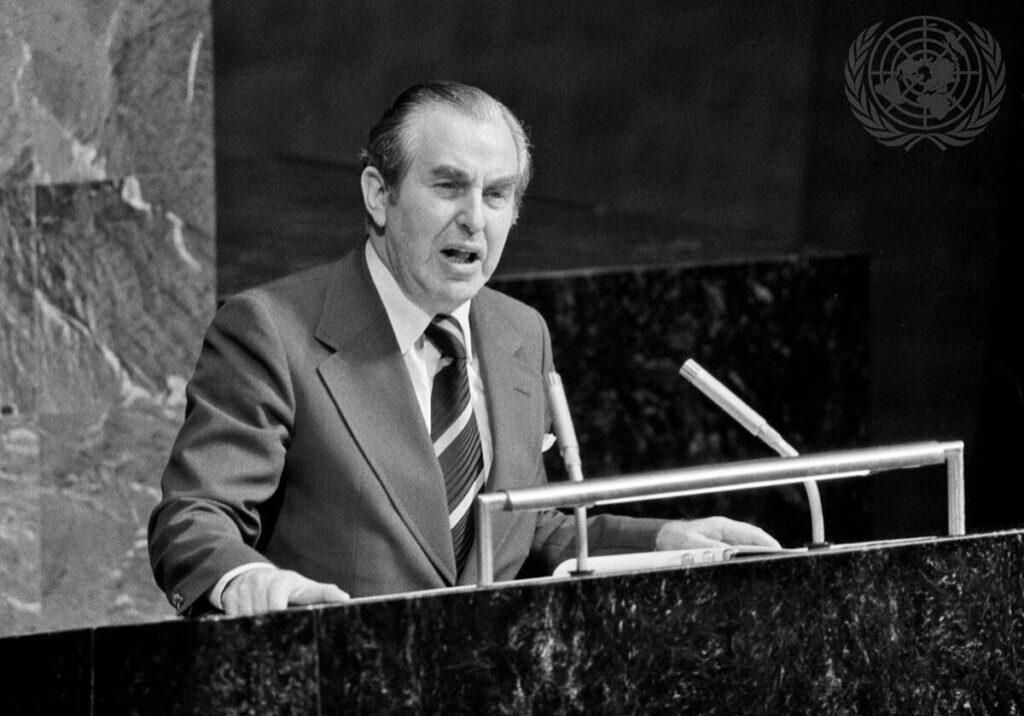Australia/Israel Review
“Land Swaps” and the 1967 lines
Jun 27, 2011 | Dore Gold

Dore Gold
When US President Barack Obama first made his controversial reference to the 1967 lines as the basis for future Israeli-Palestinian negotiations on May 19, 2011, he introduced one main caveat that stuck out: the idea that there would be “mutually agreed swaps” of land between the two sides. He added that both sides were entitled to “secure and recognised borders.” But the inclusion of land swaps also raised many questions.
Several months after Israel captured the West Bank and Gaza in the 1967 Six Day War, the UN Security Council defined the territorial terms of a future peace settlement in Resolution 242, which over the decades became the cornerstone for all Arab-Israeli diplomacy. At the time, the Soviets had tried to brand Israel as the aggressor in the war and force on it a full withdrawal, but Resolution 242 made clear that Israel was not expected to withdraw from all the territories that came into its possession, meaning that Israel was not required to withdraw from 100% of the West Bank.
Given this background, Prime Minister Yitzhak Rabin made clear in his last Knesset address in October 1995 that Israel would never withdraw to the 1967 lines. He stressed that Israel would have to retain control of the Jordan Valley, the great eastern, geographic barrier which provided for its security for decades since the Six Day War. He didn’t say a word about land swaps. For neither Resolution 242 nor any subsequent signed agreements with the Palestinians stipulated that Israel would have to pay for any West Bank land it would retain by handing over its own sovereign land in exchange.
So where did the idea of land swaps come from? During the mid-1990s there were multiple backchannel efforts to see if it was possible to reach a final agreement between Israel and the Palestinians. The Palestinians argued that when Israel signed a peace agreement with Egypt, it agreed to withdraw from 100% of the Sinai Peninsula. So they asked how could PLO chairman Yasser Arafat be given less than what Egyptian President Anwar Sadat received.
As a result, Israeli academics involved in these backchannel talks accepted the principle that the Palestinians would obtain 100% of the territory, just like the Egyptians, despite the language of Resolution 242, and they proposed giving Israeli land to the Palestinians as compensation for any West Bank land retained by Israel. This idea appeared in the 1995 Beilin-Abu Mazen paper, which was neither signed nor embraced by the Israeli or the Palestinian leaderships. Indeed, Abu Mazen (aka PA President Mahmoud Abbas) subsequently denied in May 1999 that any agreement of this sort existed.
There is a huge difference between Egypt and the Palestinians. Egypt was the first Arab state to make peace, and in recognition of that fact, Prime Minister Menachem Begin gave Sadat all of Sinai. Moreover, the Israeli-Egyptian border had been a recognised international boundary since the time of the Ottoman Empire. The pre-1967 Israeli boundary with the West Bank was not a real international boundary; it was only an armistice line demarcating where Arab armies had been stopped when they invaded the nascent state of Israel in 1948.
In July 2000 at the Camp David Summit, the Clinton Administration raised the land swap idea that had been proposed by Israeli academics, but neither Camp David nor the subsequent negotiating effort at Taba succeeded. Israel’s foreign minister at the time, Shlomo Ben-Ami, admitted in an interview in Haaretz on September 14, 2001: “I’m not sure that the whole idea of a land swap is feasible.” In short, when the idea was actually tested in high-stakes negotiations, the land swap idea proved to be far more difficult to implement as the basis for a final agreement.
After the collapse of the Camp David talks, President Clinton tried to summarise Israeli and Palestinian positions and put forward a US proposal that still featured the land swap. But to his credit, Clinton also stipulated: “These are my ideas. If they are not accepted, they are off the table, they go with me when I leave office.” The Clinton team informed the incoming Bush Administration about this point. Notably, land swaps were not part of the 2003 Roadmap for Peace or in the April 14, 2004 letter from President Bush to Prime Minister Ariel Sharon.
It was Prime Minister Ehud Olmert who resurrected the land swap idea in 2008 as part of newly proposed Israeli concessions that went even further than Israel’s positions at Camp David and Taba. It came up in these years in other Israeli-Palestinian contacts, as well. But Mahmoud Abbas was only willing to talk about a land swap based on 1.9% of the territory, which related to the size of areas of Jewish settlement, but which did not even touch on Israel’s security needs. So the land swap idea still proved to be unworkable.
Writing in Haaretz on May 29, 2011, Prof. Gideon Biger, from Tel Aviv University’s department of geography, warned that Israel cannot agree to a land swap greater than the equivalent of 2.5 percent of the territories since Israel does not have vast areas of empty land which can be transferred. Any land swap of greater size would involve areas of vital Israeli civilian and military infrastructure.
Furthermore, in the summaries of the past negotiations with Prime Minister Olmert, the Palestinians noted that they would be demanding land swaps of “comparable value” – meaning, they would not accept some remote sand dunes in exchange for high quality land near the centre of Israel. In short, given the limitations on the quantity and quality of territory that Israel could conceivably offer, the land swap idea was emerging as impractical.
In Jerusalem, the old pre-1967 armistice line placed the Western Wall, the Mount of Olives, and the Old City as a whole on the Arab side of the border. From 1948 to 1967, Jews were denied access to their holy sites; some 55 synagogues and religious study centres were systematically destroyed, while the Old City was ethnically cleansed of all its Jewish residents. If land swaps have to be “mutually agreed” does that give the Palestinians a veto over Israeli claims beyond the 1967 line in the Old City, like the Western Wall?
The land swap question points to a deeper dilemma in US-Israel relations. What is the standing of ideas from failed negotiations in the past that appear in the diplomatic record? President Obama told the American-Israel Public Affairs Committee (AIPAC) on May 22 that the 1967 lines with land swaps “has long been the basis for discussions among the parties, including previous US administrations.” Just because an idea was discussed in the past, does that make it part of the diplomatic agenda in the future, even if the idea was never part of any legally binding, signed agreements?
Fortunately, there are other points in President Obama’s recent remarks about Israeli-Palestinian negotiations that can take the parties away from the 1967 lines and assuage the Israeli side. At AIPAC, the president spoke about “the new demographic realities on the ground” which appears to take into account the large settlement blocs that Israel will eventually incorporate. Using the language of Resolution 242, Obama referred to “secure and recognised borders,” and importantly added: “Israel must be able to defend itself – by itself – against any threat.”
However, for Israelis, mentioning the 1967 lines without these qualifications brings back memories of an Israel that was 14 kilometres wide, and a time when its vulnerability turned it into a repeated target of hegemonial powers of the Middle East, that made its destruction their principal cause. Sure, Israel won the Six Day War from the 1967 lines, but it had to resort to a preemptive strike as four armies converged on its borders. No Israeli would like to live with such a short fuse again. The alternative to the 1967 lines are defensible borders, which must emerge if a viable peace is to be reached.
Dr. Dore Gold, a former Israeli ambassador to the United Nations, is President of the Jerusalem Centre for Public Affairs. © Weekly Standard, reprinted by permission, all rights reserved.
Tags: Israel






